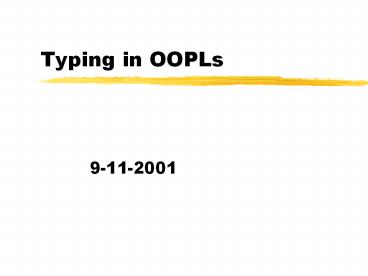Typing in OOPLs PowerPoint PPT Presentation
Title: Typing in OOPLs
1
Typing in OOPLs
- 9-11-2001
2
Typing in General
- Strong vs. Weak
- In a strongly typed language, every statement in
the language is checked for type either at
compile time or at run time. The types of
assignments, parameters, etc. will ALWAYS agree
in a strongly typed language or an error occurs. - Static vs. Dynamic
- Static checking is done at compile time, dynamic
checking at runtime.
3
Two Uses of Inheritance
- Inheritance for reuse This is probably one of
the main things you learned about inheritance
here. However, I personally feel that it hasnt
worked all that well. - Inheritance for subtyping This is largely what
we are concerned with in this class. Java
expanded on this by having interfaces.
4
Assignment Rules
- You can make an assignment of ut (with types U
and T) when - TltU - always with no check
- UltT - this is a narrowing operation and requires
a runtime check. In Java or C it would require
an explicit cast. - Their rule for ordinal types isnt used much in
modern languages.
5
Arrays
- What you can do with arrays depends significantly
on how the language deals with arrays. - In Java arrays are objects and all objects are
references so it is easy to put elements of a
subtype in an array of the supertype. - In C the array actually allocates a block of
memory to store things.
6
Name Equivalence vs. Structural Equivalence
- The languages you are likely to work with use
name equivalence. Types are compared in relation
to their declarations. - Structural equivalence seems to have generally
lost the battle here. Part of that is because we
dont want unintended overlaps. - Java can deal with this somewhat because of the
compact size of bytecodes.
7
Inclusion Polymorphism
- One feature of a subtype is that an object of any
subtype can used in place of an object of a
supertype. - This leads to a form of universal polymorphism
called inclusion polymorphism. Code can be
written once to work with a supertype and the
same code can be executed with any subtype.
8
Virtual Functions
- In order to fully take advantage of inclusion
polymorphism, objects need to be able to perform
specialized behaviors depending on type for a
given function call. That is to say that when a
method foo of an object is invoked it should be
able to call a method specialized the the
specific suptype and not just the function of the
supertype. This is what virtual functions do.
9
Virtual Function Tables
- The simplest method of implementing virtual
functions is through virtual function tables.
This only works with a simple implementation when
the language has only single inheritance. - When you have single inheritance, the functions
and data members of a class can be numbered where
the new members and methods of subclasses have
higher numbers.
10
Single vs. Multiple Inheritance
- In a language with multiple inheritance the
implementation is more difficult (we might read a
paper by Stroustrup on how C implements this).
However, the general idea remains the same. - Not all languages use this type of implementation
to achieve Universal polymorphism. Smalltalk and
JavaScript resolve function calls at runtime.
Templates and Java generics (should be present in
1.4) enable resolution without subtyping at
compile time.
11
Minute Essay
- Are there things we talked about today that you
think we need to discuss more? What other topics
do you think need to be discussed before we
launch into pointer analysis? Would you like to
have a discussion of hardware to help motivate
some of the optimization techniques? Would you
like me to make the Stroustrup paper the paper
for next class?

